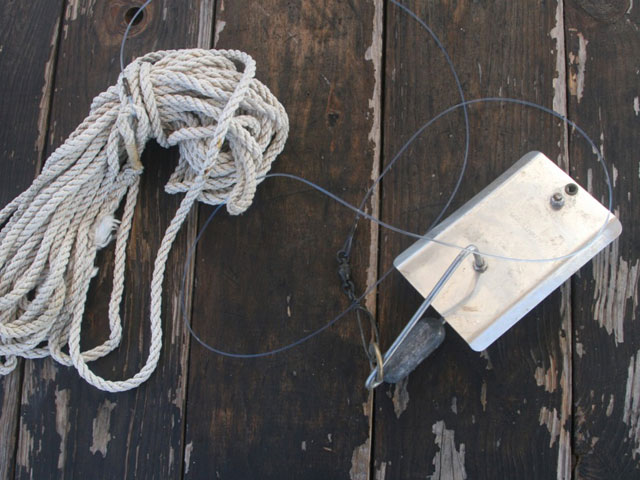Professional fishermen learned decades ago how to increase their catches by trolling deep lines. At first, anglers relied on metallic lines--either stainless steel or Monel--to get baits deep, which often resulted in incredible tangles while excluding any possibility of an IGFA World Record. Now, thanks to the advent of gel-spun superbraid, the outlook has changed for the better-- thanks to an ingenious invention known as the planer.
South Florida mate Dave Wimberly outlines two popular ways to fish a planer -- either affixed directly to the main line, or rigged like a downrigger (a.k.a. "slaughter fishing").
WHY SUPERBRAID?
Today's modern superbraids are incredibly thin in ratio to their strength and resistant to stretching, so they cut through the water much better than mono when used to fish a planer. Superbraids allow the mate or angler to easily trip the planer by hand--all-but-impossible with a line that stretches. Superbraid has also proven itself quite user-friendly when compared to cable or wire, making nightmare tangles a thing of the past with a properly deployed planer.
PLANER BASICS
The mechanics of how a planer works is pretty straightforward. Acting as a hydrofoil that dives when drawn through the water, planers efficiently deliver your baits into the deeper strike zones where kingfish and wahoo are often more prevalent. All planers are designed to trip when a fish hits the bait, reducing resistance in the water and allowing for an easier fight.
A rounded selection of planers in assorted sizes form an integral part of most professional angler's arsenals. Wimberly fishes a number of sizes at once in different positions behind the boat.
"On our main lines I rely on #4 and #6 size planers, and drop everything back either 'long' or 'short.' But I only fish one long at a time," Wimberly says. He marks his planer lines with wax line (or Dentotape), and colors the marks with a waterproof pen to keep things organized.
PROPER DEPLOYMENT
Wimberly drops his long line back nearly 300 feet, which at trolling speed carries the bait down 50 feet. When he's fishing just one planer, it goes on the left side of the boat, and when the captain turns, it's to the left in order to prevent tangles. If Wimberly sets out a second planer, the captain will turn away from it, widening the spread.
Up close, Wimberly pulls a larger planer. If his long line is rigged with a #4, he prefers a #6 on the short line. This setup is designed to prevent tangles. Pulled 100 feet back on 100-pound Power-Pro, the #6 carries baits down approximately 25 feet.
While both baits -- like the Classic Mullet Strip -- and lures can be successfully run on planers, Wimberly offers a special warning when deploying spoons.
"Never pull a spoon on your short line--not if you're also fishing a long one," he says. "If the spoon catches the long line, it'll create an unimaginable tangle. You'll end-up trashing both rigs and starting over."
Pros typically run 80- to 100-pound Power-Pro on their planer reels according to Wimberly, with no provision for the light stuff. A planer tends to eat-up line as the braid moves through the rod guides under constant pressure, so it's a good idea to routinely check for frayed or worn line and cut it back as needed.
Unless they're specifically targeting wahoo, pros like Wimberly rely on a mix of fluorocarbon leaders with heavy mono main lines for their bait reels. He starts off with 10-15 feet of 100 pound-test fluoro attached to the bait, and splices it to 60 to 70 feet of 100 pound mono with a barrel knot. Aim for a total of 75 to 80 feet between the bait and the planer when trolling.
SLAUGHTER FISHING
A specialized method of going deep is known as "slaughter fishing." Here, the mate will typically drag two large planers attached to cleats beneath the transom. Several feet of 400 pound mono or rope are attached to the cleats, protecting the boat's transom, followed by a length of super-heavy Power-Pro which is joined to directly to each planer's pull ring.
Wimberly get the baits to the usual distance of 70 to 80 feet from the planer using a rubber-band breakaway rig. When deploying the lines, the mate hooks a double-ended snap swivel through each rubber band near the rod tip. He then free-spools the line with the baits attached back into the wake. Friction against the belly of line causes the baits to sink, and they work their way down the planer line into the proper position.
When a fish strikes the bait, the rubber band snaps and the main line breaks free, allowing the angler to fight the fish without interference from the planer. With the planer out of the equation, the mate can even drop back another bait while the angler is still fighting a fish. At the end of the day both planers can be tripped by hand and recovered









